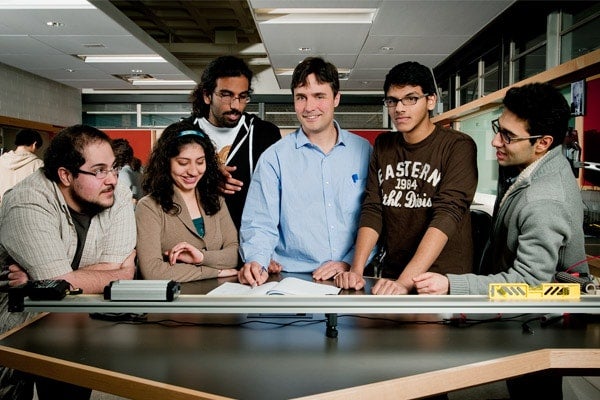
Students give high marks to new kind of science lab
Published: September 13, 2012
Intro to Physics might not be everyone’s idea of a good time, but a new style of teaching in U of T’s department of physics is giving students a collegial, hands-on way of understanding the basics of the physical universe.
Prompted by student feedback over the years and developed from leading-edge pedagogical research, the Physics Practicals are the interactive component to U of T’s introductory courses for non-physics science majors. Based on the timeless truth that you learn more by doing than by listening, the Practicals engage some 800 to 1,200 undergraduates per year in a new kind of lab experience.
“The first step is always play,” says senior lecturer Jason Harlow, who has taught the Practicals since their inception in 2008. “That’s our model – just mess around and see what you can discover.”
As an example, Harlow describes the Practicals’ lesson on circuits: “Here’s a battery, here are a couple of wires, and here’s a light bulb. Now, how do you make the light bulb work?” Together, the students figure it out. “Then, we talk about current and voltage.”
In the past, students attended both labs and tutorials – mini-lectures in which the teaching assistant would stand at the front and talk, says Harlow, who graduated from U of T with a BSc in physics in 1993. Chairs were often bolted to the ground and they all faced forward. Frequently, lab activities were not aligned with the formal lectures.
The Physics Practicals’ three rooms have been designed to include nine work stations, each with four students, who can either sit or stand around a table as they experiment, discuss and learn. Two teaching assistants circulate through the room, and all students work at the same time on the same activity, which is related to a recent lecture.
Harlow notes that the Practicals often resemble a coffee shop full of lively conversations.
“Except they’re all talking about physics,” he says. “It’s working fantastically.” Student satisfaction has risen 22 per cent over the past three years.
The Ontario Association of Physics Teachers has been following this new pedagogy; some of U of T’s course materials are now being used by the province’s high schools. And earlier this year, senior lecturer emeritus David Harrison (PhD 1972), one of the originators of the Practicals, was honoured by the Canadian Association of Physicists for his longstanding dedication to transforming physics education. (You can read more about Harrison's teaching innovation here.)
Funding is now being sought for two more rooms to accommodate advanced Practicals for the physics majors.
“We want to improve the experience for these students as well,” says Harlow.
Take a peek at the practical rooms here.



